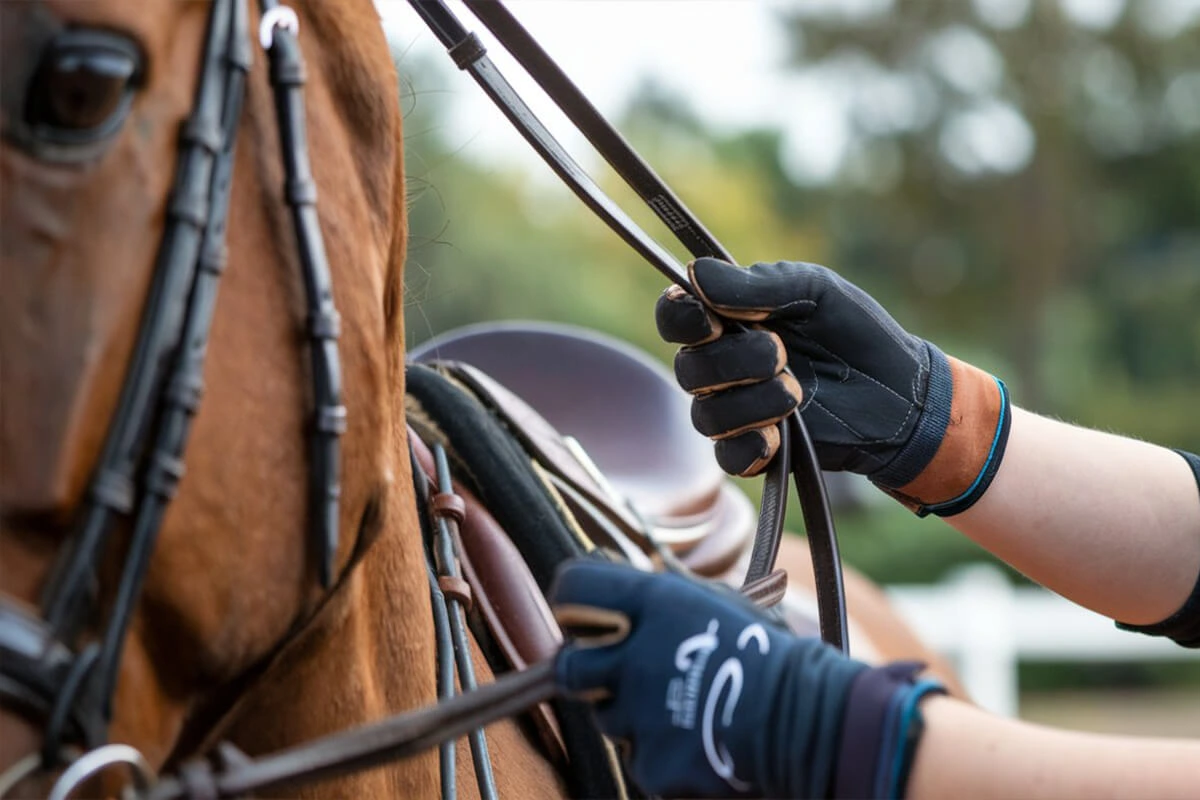Mastering horse with reins control is one of the most important skills every rider must develop to ride professionally. The reins act as a direct line of communication between you and your horse, allowing you to guide movements, adjust speed, and ensure a safe and comfortable riding experience. Without proper rein handling, even a well-trained horse may become unresponsive or confused, making riding more challenging and less enjoyable.
Understanding how to hold and use the reins correctly improves your ability to control the horse while maintaining a smooth and balanced ride. Whether you’re a beginner or an experienced rider, refining your rein-handling skills can make a significant difference in how well your horse responds to your cues. Learning different rein techniques, such as direct, indirect, and neck reining, helps create a stronger bond between horse and rider.
In this guide, we will cover 10 expert tips to help you ride like a professional. You’ll learn how to hold the reins properly, improve communication with your horse, master different riding techniques, and enhance safety while riding. By the end, you’ll have a solid understanding of how to control your horse with reins efficiently and confidently. Let’s get started!
Understanding the Basics of Holding Reins Properly
What Are Reins and Their Role in Riding?
Reins play a crucial role in horse riding, acting as the main tool for communication between the rider and the horse. A horse with reins responds to subtle hand movements, allowing the rider to control direction, speed, and stopping power. Without proper rein handling, a rider may struggle to guide the horse effectively, leading to miscommunication and potential safety risks.
Reins connect to the bridle, which includes the bit, headstall, and other tack that influence the horse’s movement. Depending on the riding style and rein technique, a rider can apply different types of pressure to signal turns, transitions, or halts. The ultimate goal of using horse with reins correctly is to achieve smooth, controlled, and effortless riding without causing discomfort or confusion to the horse.
A professional rider doesn’t rely solely on reins for control. Instead, rein usage works in harmony with leg pressure, body posture, and weight shifts. Learning to balance all these elements allows a rider to develop a light and effective touch, improving overall performance and communication with the horse.
Different Types of Reins: Western vs. English
Riders use different styles of reins depending on the riding discipline. The two primary types are Western reins and English reins, each serving different purposes and requiring unique handling techniques.
- Western Reins: Western riders typically use split reins or romal reins, which offer more flexibility and freedom. Western riders often guide their horse with reins using one hand, allowing the other hand to remain free. Neck reining—where the horse responds to pressure against the neck rather than direct rein contact—is a common technique in Western riding. This method is useful for cattle work, trail riding, and rodeo events.
- English Reins: English riders use closed-loop reins, where both ends are connected, requiring two-handed rein control. This setup provides greater precision and is essential for disciplines like dressage, show jumping, and eventing. An English rider maintains consistent contact with the horse’s mouth, using direct rein pressure to communicate more refined movements.
Choosing the right reins depends on the rider’s goals and riding discipline. Whether you ride Western or English, understanding the proper rein technique for each style helps improve control and ensures a better riding experience with your horse with reins.
How to Hold Reins Correctly for Maximum Control
Holding the reins correctly is the foundation of effective riding. A rider must maintain a firm yet gentle grip, ensuring clear communication without causing unnecessary tension. The way a rider holds the horse with reins affects the horse’s responsiveness and willingness to follow cues.
Here’s how to hold reins properly based on riding style:
- English Reins: Hold both reins in each hand, positioning them between your ring finger and pinky, then guiding them up through your palm and out over your index finger. Keep your wrists straight and thumbs on top, maintaining a light but steady contact with the horse’s mouth.
- Western Reins: If using split reins, hold them in one hand, with the excess rein draped over your other side. When using romal reins, grasp the knot at the base while letting the romal rest naturally. Keep your hand relaxed to allow smooth rein adjustments.
Regardless of style, avoid gripping too tightly, which can cause discomfort for the horse. Instead, keep a soft but secure hold, allowing slight rein movements for smoother transitions. Proper rein handling ensures that your horse with reins responds effectively to your cues while remaining relaxed and comfortable.
Common Mistakes Riders Make When Holding Reins
Many riders develop bad habits when handling reins, leading to poor communication with the horse. Understanding these mistakes helps riders correct them early and improve their overall riding technique.
- Holding the Reins Too Tight – Gripping the reins too firmly can make the horse feel restricted, causing resistance or frustration. Riders should aim for steady but gentle contact.
- Letting the Reins Go Too Loose – Allowing the horse with reins too much slack reduces control, making it harder to steer or stop quickly. Riders should maintain light, consistent contact without excessive looseness.
- Improper Hand Position – Placing hands too high, too low, or too wide can confuse the horse. Hands should remain in a neutral position, close to the rider’s body, and aligned with the horse’s mouth.
- Overusing the Reins Instead of Using Seat and Legs – Relying solely on reins without engaging leg and seat aids creates unbalanced riding. A professional rider uses their entire body to guide the horse smoothly.
- Switching Between Rein Types Incorrectly – Riders transitioning between Western and English styles should adjust their rein-holding techniques accordingly. Mixing techniques can confuse the horse with reins, leading to inconsistent responses.
Avoiding these mistakes helps riders develop a more professional approach to rein handling. By maintaining a balanced and controlled grip, riders can achieve smooth communication, making their horse with reins more responsive and cooperative during rides.
Mastering Horse Riding Techniques with Reins
Using Reins for Steering and Stopping
Controlling a horse with reins requires precise movements to guide direction and regulate speed. Riders must learn how to steer and stop their horse effectively without causing confusion or discomfort. Proper rein handling allows smoother transitions and helps the horse understand what the rider wants.
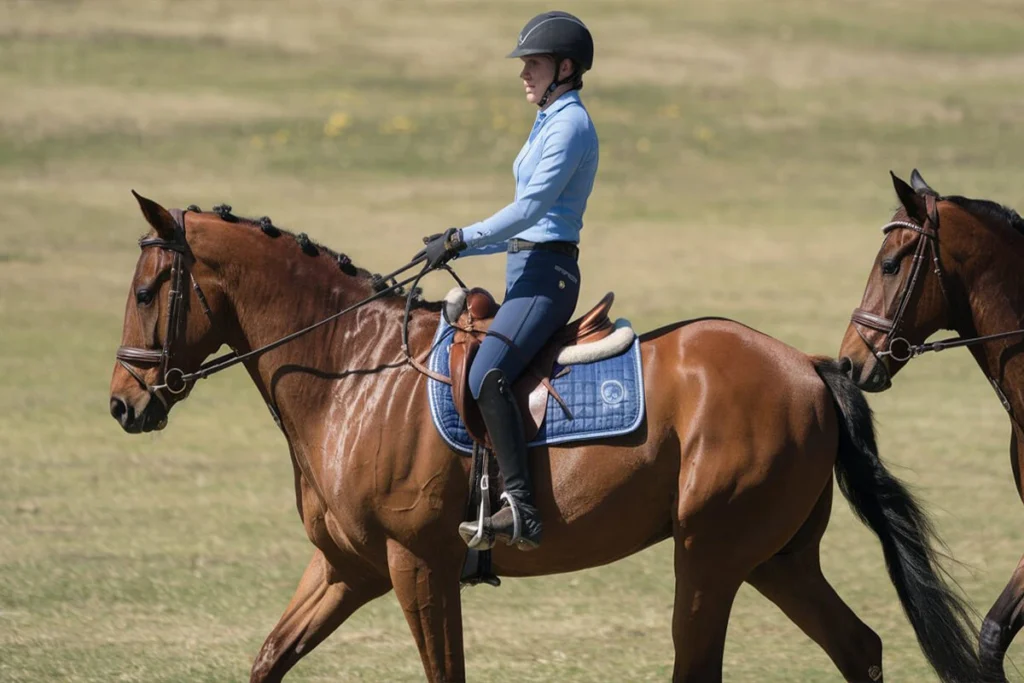
Steering with Reins
To steer a horse with reins, riders can use either direct rein or neck rein techniques, depending on their riding style.
- Direct Rein (Used in English and Western Riding): Pull the rein slightly in the direction you want to go. If you want the horse to turn left, gently pull the left rein toward your hip while keeping steady contact on the right rein. This method provides clear guidance for precise turns.
- Neck Rein (Used in Western Riding): Lay the rein against the horse’s neck instead of pulling it. If you want the horse to turn left, move the right rein against its neck, signaling the turn without direct pressure on the bit. This technique works well for one-handed riding.
Stopping with Reins
Bringing a horse with reins to a stop requires a balanced and controlled approach. Jerking the reins can startle the horse, leading to resistance or an abrupt halt that throws the rider off balance. Instead, follow these steps:
- Sit deep in the saddle and engage your core to signal a slow-down before using the reins.
- Gently squeeze the reins rather than pulling harshly. A gradual increase in pressure tells the horse to slow down smoothly.
- Release pressure immediately once the horse stops. Holding the reins too tight after stopping can confuse the horse and create tension.
Practicing these rein techniques improves communication, making it easier to guide a horse with reins confidently.
Reins Grip: How Firm Should It Be?
Many riders struggle with finding the right balance between holding the horse with reins too tightly or too loosely. A proper grip allows clear signals while keeping the horse comfortable.
Too Tight vs. Too Loose Grip
- Holding the reins too tight can make the horse feel restricted, causing frustration and resistance. The horse might toss its head or pull against the pressure, making riding more difficult.
- Letting the reins too loose reduces control, making it harder to steer or stop the horse with reins effectively. A horse might ignore cues or become unresponsive to the rider’s commands.
Finding the Right Grip
The ideal rein grip keeps a steady connection with the horse’s mouth without unnecessary tension. Follow these tips to achieve the perfect balance:
- Keep fingers closed but relaxed around the reins. Avoid squeezing too hard, which can make rein movements stiff.
- Use a light, elastic contact that allows slight movement while maintaining control. This makes communication with the horse more natural.
- Adjust grip based on the riding discipline. English riders generally maintain more consistent contact, while Western riders often allow more rein length for flexibility.
Developing a proper rein grip helps the horse with reins stay relaxed and responsive, improving overall riding performance.
Canter & Trot: Rein Techniques for Different Gaits
A horse with reins moves differently at each gait, so riders must adjust rein handling to maintain smooth control. Understanding how to use reins properly at the trot and canter ensures better balance and communication.
Using Reins at the Trot
The trot is a two-beat gait where the horse moves diagonally opposite legs together. Riders must keep steady rein contact to maintain rhythm and prevent excessive head movement.
- Maintain even rein pressure to avoid bouncing or abrupt movements that might confuse the horse.
- Follow the horse’s movement with soft hands by allowing the reins to move slightly with the horse’s head. This prevents stiffness in communication.
- Use half-halts to prepare for transitions. Lightly squeezing the reins signals the horse to slow down or prepare for the next movement.
Using Reins at the Canter
The canter is a three-beat gait that requires more rein control to maintain balance and direction.
- Keep a steady but flexible rein connection to help the horse stay collected without restricting forward movement.
- Use outside rein support to guide the horse into the correct lead. Slightly tighten the outside rein while softening the inside rein to encourage the horse to pick up the correct canter.
- Avoid excessive rein movement, which can unbalance the horse with reins. Instead, keep hands steady and follow the horse’s natural motion.
Mastering rein techniques for different gaits helps riders maintain better control and allows the horse with reins to move comfortably through transitions.
The Role of Rider Posture in Rein Control
A rider’s posture directly affects how well a horse with reins responds to rein cues. Poor posture can create mixed signals, while proper alignment improves communication and balance.
How Posture Affects Rein Control
- Leaning too far forward puts excessive weight on the horse’s front end, making it harder to stop or slow down.
- Slouching backward reduces rein effectiveness and may cause the horse to misunderstand signals.
- Gripping reins with stiff hands creates a rigid connection, making the horse resistant to cues.
Achieving the Right Riding Posture
- Keep shoulders back and relaxed. This prevents unnecessary tension and improves rein communication.
- Engage your core for stability. A strong core allows subtle rein adjustments without losing balance.
- Keep elbows bent and close to your body. This position ensures smoother rein control and prevents excessive pulling.
When riders maintain proper posture, they create a more effective partnership with their horse with reins, leading to better performance and responsiveness.
Improving Horse-Rider Communication Through Rein Handling
How Reins Affect Horse Responsiveness
The way a rider handles reins directly influences how well a horse with reins responds to cues. Proper rein control creates clear communication, while poor rein handling can confuse the horse, making it unresponsive or resistant.
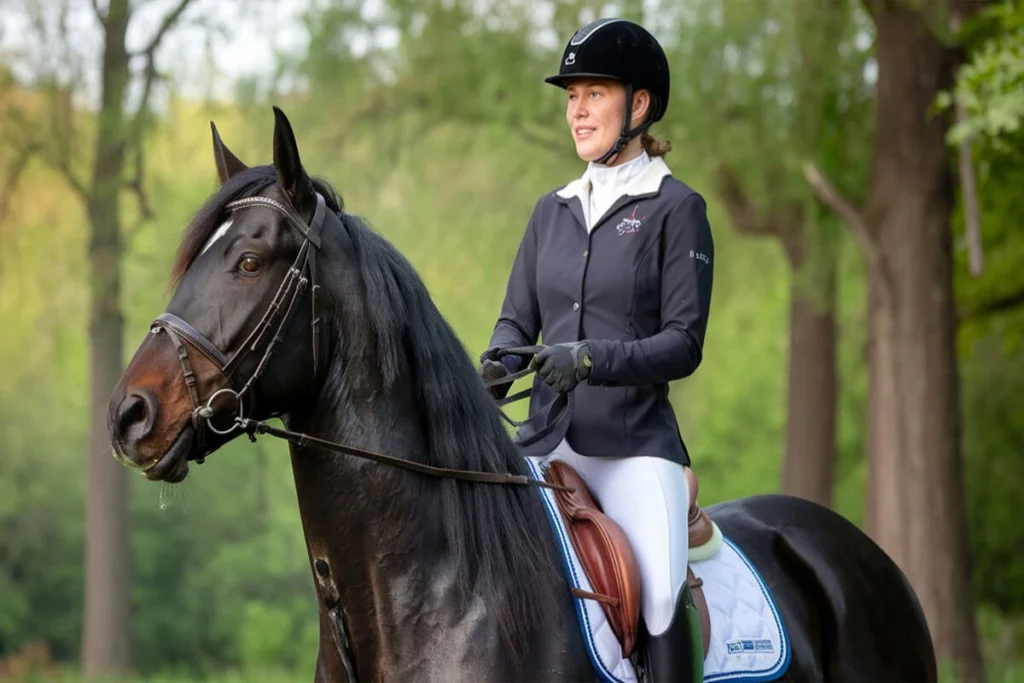
How Horses Interpret Rein Pressure
A horse with reins relies on rein pressure to understand the rider’s commands. Horses respond to three main types of rein pressure:
- Light contact – Encourages the horse to stay engaged without restriction.
- Increased pressure – Signals a request for a transition, such as slowing down or stopping.
- Release of pressure – Rewards the horse for responding correctly, reinforcing good behavior.
Riders must adjust rein pressure based on the situation. Holding the reins too tightly can cause the horse to feel trapped, while inconsistent rein contact can make cues unclear. Developing a steady, balanced connection helps the horse with reins respond more accurately.
Common Rider Mistakes That Affect Horse Responsiveness
- Overusing the reins – Relying too much on the reins for control instead of using leg and seat aids.
- Inconsistent rein pressure – Alternating between loose and tight reins, which confuses the horse.
- Pulling instead of guiding – Yanking the reins instead of making gentle, gradual adjustments.
When riders use reins correctly, their horse with reins becomes more responsive, relaxed, and willing to follow commands.
Using Rein Aids Effectively
Rein aids help a horse with reins understand what the rider wants. Riders use four types of rein aids to communicate different instructions.
1. Direct Rein Aid
- Used for steering and turning.
- The rider gently pulls the rein in the desired direction while maintaining light contact on the opposite rein.
- Commonly used in English and Western riding.
2. Indirect Rein Aid
- Helps shape the horse’s movement without direct pulling.
- The rider applies pressure on one rein toward the opposite shoulder to encourage balance and bending.
3. Opening Rein Aid
- Also known as a leading rein, used for guiding the horse in a specific direction.
- The rider moves one rein slightly away from the neck, creating a clear path for the horse to follow.
4. Neck Rein Aid
- Common in Western riding.
- The rider lays the rein against the horse’s neck instead of pulling. This signals the horse to turn in the opposite direction.
Using rein aids properly allows the horse with reins to stay balanced, responsive, and relaxed. Combining rein aids with seat and leg cues enhances overall communication between horse and rider.
How to Develop Light Hands for Better Connection
Riders must develop light hands to maintain a soft yet effective connection with their horse with reins. Heavy-handed rein control can create discomfort, while overly loose hands lead to weak communication.
The Importance of Light Hands
A horse with reins moves more freely and confidently when the rider’s hands are soft and responsive. Light hands prevent unnecessary tension and help the horse stay calm. Instead of pulling, riders should focus on giving, taking, and following the horse’s natural movements.
Tips to Develop Lighter Hands
- Keep fingers closed but relaxed – Avoid gripping too tightly; instead, allow subtle movements in the reins.
- Maintain soft, elastic contact – Follow the horse’s head movement without stiffness.
- Use the seat and legs more – Rely on body cues instead of overusing the reins for control.
- Practice transitions with minimal rein pressure – Ask the horse with reins to slow down using weight shifts before applying rein pressure.
By developing light hands, riders create a better bond with their horse with reins, making riding more fluid and comfortable.
Exercises to Improve Rein Communication
Riders can improve their rein communication with targeted exercises that develop balance, coordination, and feel. Practicing these exercises helps create a stronger connection with a horse with reins.
1. One-Handed Riding
- Ride with one hand on the reins while keeping the other hand on your thigh.
- This exercise encourages riders to rely more on seat and leg aids instead of rein pressure.
2. Rein Pressure Awareness
- Hold the reins and close your fingers slightly to feel the amount of pressure applied.
- Gradually increase and decrease rein pressure while noting how the horse with reins reacts.
3. Transitions Without Reins
- Practice stopping and slowing down using only seat and leg aids before lightly engaging the reins.
- This teaches riders to depend less on rein pulling for control.
4. Serpentine and Circle Exercises
- Guide the horse with reins through figure-eight patterns or circles to improve steering and rein handling.
- Focus on smooth rein adjustments instead of abrupt pulls.
Regularly practicing these exercises refines a rider’s rein skills, allowing better control and clearer communication with a horse with reins.
Horse Riding Safety and Rein Control
How to Prevent Accidents with Proper Rein Handling
A horse with reins relies on the rider’s signals for direction and control. Improper rein handling can lead to confusion, miscommunication, and even dangerous situations. Riders must learn how to use reins correctly to maintain safety for both themselves and their horse.
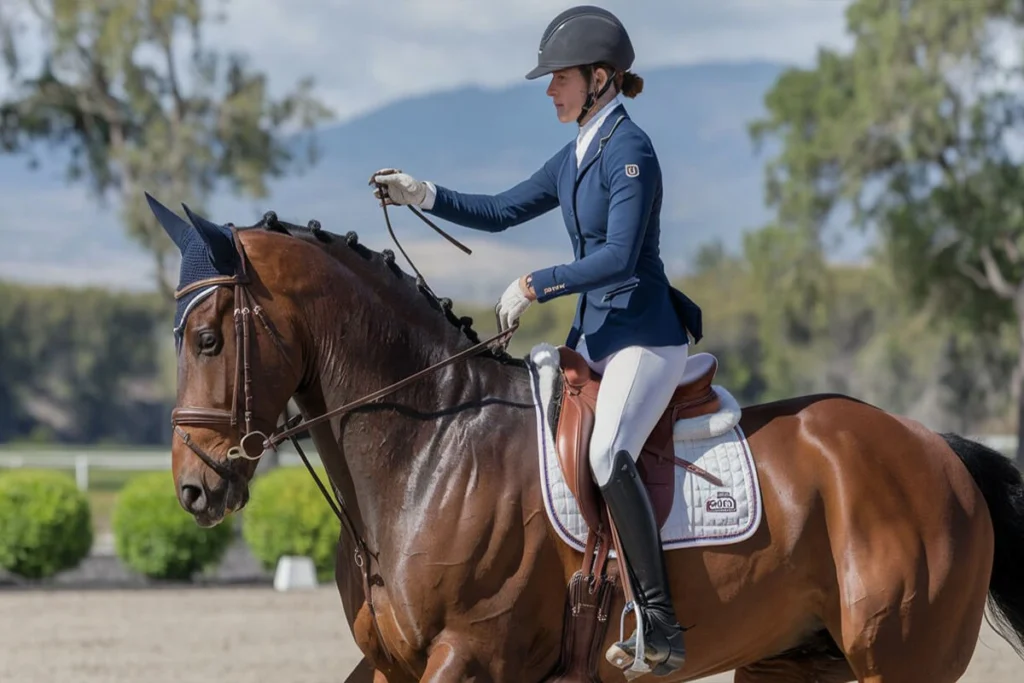
Common Rein-Related Accidents and How to Avoid Them
- Sudden Stops or Head Tossing – Pulling too hard on the reins can cause a horse with reins to throw its head, rear up, or stop abruptly, possibly unseating the rider.
- Solution: Apply gentle, gradual pressure instead of yanking the reins. Release pressure immediately after the horse responds.
- Losing Control Due to Loose Reins – Allowing too much slack in the reins can make it difficult to steer or stop quickly, especially in unexpected situations.
- Solution: Keep a steady but light contact, adjusting rein length based on riding speed and terrain.
- Tripping or Stumbling from Overuse of Reins – Constant rein pulling forces the horse to shift too much weight onto its front legs, increasing the risk of stumbling.
- Solution: Balance rein use with seat and leg aids, allowing the horse to move naturally.
By focusing on smooth, controlled rein movements, riders can guide a horse with reins safely and confidently, reducing the risk of accidents.
The Importance of Using a Suitable Bridle and Bit
The bridle and bit play a crucial role in how a horse with reins responds to rider commands. Using the wrong equipment can cause discomfort, miscommunication, or even resistance from the horse.
Choosing the Right Bridle
The bridle secures the horse with reins, allowing the rider to guide movement. Different styles of bridles suit different riding disciplines:
- English Bridle – Includes a noseband and generally requires steady rein contact. Used for dressage, show jumping, and eventing.
- Western Bridle – Often lacks a noseband and allows for looser rein handling. Used in Western riding, trail riding, and ranch work.
A well-fitted bridle prevents pressure points and discomfort, ensuring the horse remains responsive.
Selecting the Right Bit
The bit sits inside the horse’s mouth and connects to the reins. Bits come in different types, each influencing rein control differently:
- Snaffle Bit – Offers direct rein contact, commonly used for training and English riding.
- Curb Bit – Uses leverage to apply pressure, often seen in Western riding.
- Hackamore – A bitless option that controls the horse with reins through nose pressure.
If a horse resists rein cues, shakes its head, or refuses to stop, the bit or bridle may be uncomfortable. Riders should regularly check tack fit and seek expert advice if needed.
Signs You’re Using Too Much Rein Pressure
Applying too much rein pressure can cause a horse with reins to become tense, unresponsive, or even resistant. Riders must recognize when they’re using excessive force and adjust their rein handling accordingly.
Physical Signs of Too Much Rein Pressure
- The horse tosses or shakes its head – Indicates discomfort from constant or harsh pressure.
- The horse’s mouth opens or chomps on the bit – A sign of resistance due to excessive rein tension.
- The horse slows down too much or refuses to move forward – Too much rein pressure can discourage forward movement.
Behavioral Signs of Excessive Rein Use
- The horse pulls against the reins – This is a defensive reaction to avoid uncomfortable pressure.
- The horse becomes stiff and unresponsive – Too much rein pressure can create tension, making it difficult for the horse to follow cues smoothly.
- The horse stumbles or trips frequently – Overuse of reins can force the horse onto its front legs, making it unbalanced.
How to Reduce Rein Pressure
- Practice soft, steady contact instead of pulling. Use small rein adjustments rather than constant tension.
- Engage seat and leg aids more to reduce reliance on rein control.
- Use half-halts instead of prolonged rein pressure to communicate transitions.
A horse with reins responds best when the rider maintains a light but clear connection, avoiding unnecessary force.
When to Seek Guidance from a Riding Instructor
Even experienced riders can benefit from professional training. If a horse with reins isn’t responding well or if a rider struggles with rein control, a qualified instructor can provide valuable guidance.
Signs You Need a Riding Instructor
- Your horse isn’t responding to rein cues properly – If turns, stops, or speed changes feel inconsistent, professional help can refine rein techniques.
- You rely too much on reins instead of seat and leg aids – An instructor can teach better balance and body control.
- You struggle with rein tension and grip – If you’re unsure whether you’re holding the reins too tight or too loose, a trainer can provide corrections.
- Your horse shows signs of discomfort or resistance – A riding instructor can assess whether rein handling, tack fit, or another factor is causing issues.
- You feel unsure about rein techniques for different gaits – Professional guidance can help improve rein control for walking, trotting, and cantering.
Benefits of Professional Training
- Personalized feedback on rein handling techniques.
- Corrections for posture and body alignment to improve rein control.
- Guidance on choosing the right bridle, bit, and reins for better communication with the horse with reins.
Seeking expert instruction helps riders develop confidence and refine their skills, ensuring better control and communication with their horse with reins.
Advanced Tips for Professional-Level Riding
Fine-Tuning Rein Sensitivity for Advanced Riding
Mastering rein sensitivity is crucial for advanced riders who want to establish seamless communication with their horse with reins. A finely tuned connection allows subtle cues to guide the horse effortlessly, making movements more fluid and precise.
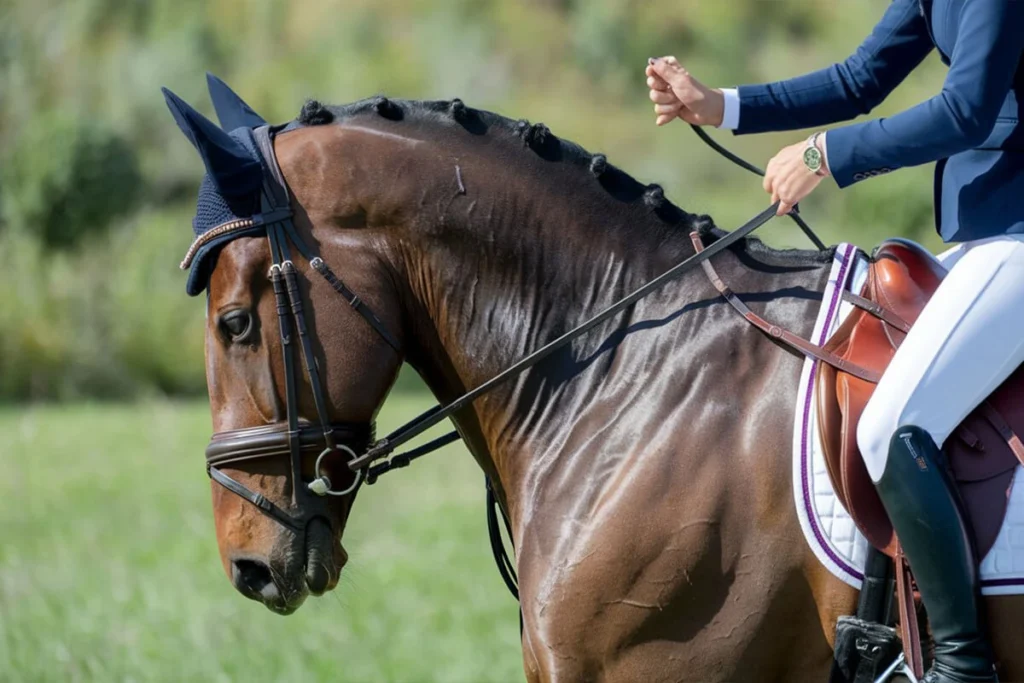
Why Rein Sensitivity Matters
A horse with reins should respond to the lightest touch, avoiding the need for excessive rein pressure. Fine rein sensitivity helps with:
- Better balance and control – The horse remains light on its feet and responsive.
- Smoother transitions – Subtle rein adjustments make gait changes seamless.
- Improved collection and engagement – The horse carries itself with better posture and energy.
Techniques to Improve Rein Sensitivity
- Refine hand movements – Use small, intentional rein cues instead of broad movements.
- Practice half-halts – A brief squeeze and release encourage responsiveness without abrupt stopping.
- Sync with your horse’s rhythm – Match rein contact to the natural movement of the horse with reins to avoid resistance.
- Experiment with lighter rein contact – Gradually decrease rein pressure to encourage the horse to respond to minimal cues.
Advanced riders develop rein sensitivity by practicing precision and consistency, ensuring their horse with reins remains light, engaged, and responsive.
When and How to Ride with One Hand
Riding with one hand requires balance, skill, and a well-trained horse with reins that understands subtle rein and body cues. This technique is commonly used in Western riding, dressage freestyle, and advanced bridleless riding.
When Should You Ride with One Hand?
- In Western riding – Neck reining allows riders to control the horse using one hand while keeping the other free for tasks like roping.
- During advanced training – Riding with one hand refines rein communication and encourages riders to rely more on seat and leg aids.
- For competition or performance – Some disciplines require one-handed rein use for precision and style.
How to Ride with One Hand Successfully
- Use neck reining techniques – Move the rein across the horse’s neck instead of direct pulling.
- Maintain a centered, balanced seat – A strong core ensures stability without relying on rein contact.
- Guide with legs and seat – Since less rein control is available, use subtle body shifts to communicate with the horse with reins.
- Keep rein contact soft – Avoid stiffness in the wrist or arm, which can confuse the horse.
Riding with one hand strengthens a rider’s overall communication and control, improving their partnership with their horse with reins.
Training a Horse to Respond Lightly to Rein Cues
A well-trained horse with reins should respond to the lightest rein pressure. Teaching a horse to be light and responsive takes patience, consistency, and proper reinforcement.
Steps to Train a Horse for Light Rein Cues
- Start with Groundwork – Before riding, use groundwork exercises with a bridle to teach rein pressure and release.
- Use Progressive Rein Aids – Begin with light contact, increase pressure only when necessary, and reward even the smallest correct responses.
- Incorporate Half-Halts – Short squeezes with an immediate release teach the horse with reins to stay attentive without relying on heavy rein pressure.
- Reward Quick Responses – As soon as the horse reacts correctly, soften the reins to reinforce lightness.
- Avoid Overuse of Hands – Instead of relying on the reins for control, use leg and seat cues to guide movement.
Troubleshooting Common Problems
- If the horse leans on the reins → Use more seat and leg cues to encourage self-carriage.
- If the horse ignores light rein cues → Apply a firmer cue, then immediately soften once the horse responds.
- If the horse overreacts to rein pressure → Use a gentler bit or practice desensitization exercises.
By reinforcing lightness and responsiveness, a horse with reins will develop better balance, confidence, and willingness to follow subtle cues.
Combining Rein Handling with Leg and Seat Aids
A skilled rider does not rely solely on the reins to control a horse with reins. Instead, they use a combination of reins, leg pressure, and seat position to communicate effectively.
The Role of Leg and Seat Aids in Rein Control
- Leg pressure guides direction and speed – Inner leg pressure encourages bending, while outer leg pressure maintains straightness.
- Seat position signals movement – Shifting weight forward encourages forward motion, while sitting deeper helps slow the horse.
- Reins refine cues, not force movement – A balanced rider uses rein aids lightly, allowing leg and seat cues to do most of the work.
Exercises to Improve Coordination Between Reins, Legs, and Seat
- Leg-Yielding Practice
- Apply light rein pressure while using leg aids to encourage the horse to move sideways.
- Transition Control Without Reins
- Practice stopping and slowing down using only seat and leg shifts before applying rein cues.
- Figure-Eight Patterns
- Guide the horse with reins through turns primarily using seat and leg adjustments, reinforcing balanced communication.
When rein handling is combined with proper seat and leg aids, a horse with reins responds more naturally and fluidly, resulting in a smoother and more effective riding experience.
Conclusion
Mastering rein handling transforms the way you communicate with your horse with reins. Proper rein techniques improve control, responsiveness, and overall riding experience. Whether you are a beginner learning the basics or an advanced rider refining rein sensitivity, understanding how to hold, adjust, and use the reins effectively creates a stronger bond with your horse.
Reins serve as an extension of your hands, but they should never be your only means of control. Combining rein cues with seat and leg aids ensures that your horse moves naturally and comfortably. Light, consistent rein contact encourages better responses, while excessive pressure can cause resistance and discomfort. Fine-tuning your rein sensitivity allows for smoother transitions, balanced movement, and greater harmony between you and your horse.
Selecting the right tack, including a suitable bridle and bit, plays a crucial role in rein communication. If your horse displays signs of discomfort, reassess your rein handling and equipment. Rein pressure should always be minimal yet effective, guiding your horse rather than forcing movement.
Every rider benefits from continuous learning. If you struggle with rein control, seek guidance from a riding instructor to refine your techniques. Practice exercises that improve rein coordination, experiment with one-handed riding, and focus on developing a lighter touch for better connection.
A horse with reins responds best when its rider communicates with precision, patience, and clarity. By improving your rein handling skills, you enhance not just your riding ability but also your horse’s confidence, trust, and willingness to work with you. Keep refining your technique, stay mindful of your horse’s reactions, and enjoy the journey toward professional riding mastery.
Learn The Best Way To Care for your Horse For A long Healthy Life Here!
Learn More about Pets and Different breeds From HERE!
Find out the Latest stuff for your Pet On Pet MD Official
